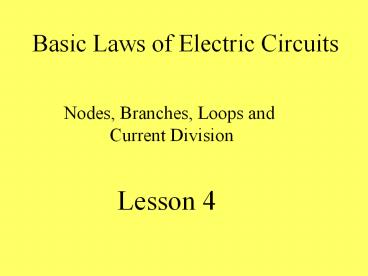Basic Laws of Electric Circuits - PowerPoint PPT Presentation
Title:
Basic Laws of Electric Circuits
Description:
A branch: A branch is a single electrical element or device. ... Figure 4.10: Circuit for Example 4.4. 17 Basic Laws of Electric Circuits Current Division: ... – PowerPoint PPT presentation
Number of Views:1054
Avg rating:3.0/5.0
Title: Basic Laws of Electric Circuits
1
Basic Laws of Electric Circuits
Nodes, Branches, Loops and Current Division
Lesson 4
2
Basic Laws of Electric Circuits
Nodes, Branches, and Loops
?
Before going further in circuit theory, we
consider the structure of electric circuits and
the names given to various member that make up
the structure.
?
We define an electric circuit as a connection of
electrical devices that form one or more closed
paths.
?
Electrical devices can include, but are not
limited to,
resistors transistors
transformers capacitors logic devices
light bulbs inductors switches
batteries
1
3
Basic Laws of Electric Circuits
Nodes, Branches, and Loops
A branch A branch is a single electrical element
or device.
?
?
?
?
?
Figure 4.1 A circuit with 5 branches.
A node A node can be defined as a connection
point between two or more branches.
?
?
?
Figure 4.2 A circuit with 3 nodes.
2
4
Basic Laws of Electric Circuits
Nodes, Branches, and Loops
?
If we start at any point in a circuit (node),
proceed through connected electric devices back
to the point (node) from which we started,
without crossing a node more than one time, we
form a closed-path.
?
A loop is a closed-path.
?
An independent loop is one that contains at least
one element not contained in another loop.
3
5
Basic Laws of Electric Circuits
Nodes, Branches, and Loops
?
The relationship between nodes, branches and
loops can be expressed as follows
branches loops nodes - 1
or
B L N - 1
Eq. 4.1
?
In using the above equation, the number of loops
are restricted to be those that are independent.
?
In solving most of the circuits in this course,
we will not need to resort to Eq. 4.1. However,
there are times when it is helpful to use this
equation to check our analysis.
4
6
Basic Laws of Electric Circuits
Nodes, Branches, and Loops
Consider the circuit shown in Figure 4.3.
Figure 4.3 A multi-loop circuit
give the number of nodes give the number of
independent loops give the number of
branches verify Eq. 4.1
5
7
Basic Laws of Electric Circuits
Single Node Pair Circuits
Current division.
A single node pair circuit is shown in Figure 4.4
Figure 4.4 A circuit with a single node pair.
We would like to determine how the current
divides (splits) in the circuit.
6
8
Basic Laws of Electric Circuits
Single Node Pair Circuits
Current division.
Eq. 4.2
Eq. 4.3
Therefore
Eq. 4.4
7
9
Basic Laws of Electric Circuits
Single Node Pair Circuits
Current division.
From Eq. 4.4 we can write,
Eq. 4.5
Equation 4.5 is a very important expression. In
words it says that the equivalent of two
resistors in parallel equals to the product of
the two resistors divided by the sum.
The equivalent resistance of two resistors in
parallel is always less than the smallest
resistor.
8
10
Basic Laws of Electric Circuits
Single Node Pair Circuits
Current division.
In general, if we have N resistors in parallel as
in Figure 4.5
Figure 4.5 Resistors in parallel.
Eq. 4.6
9
11
Basic Laws of Electric Circuits
Single Node Pair Circuits
Current division.
Back to current division We can write from
Figure 4.4
In summary form
Eq. 4.7
The above tells us how a current I divides when
fed into two resistors in parallel. Important
10
12
Basic Laws of Electric Circuits
Single Node Pair Circuits
Current division.
In general, if we have N resistors in parallel
and we want to find the current in, say, the jth
resistor, as shown in Figure 4.6,
Figure 4.6 General case for current division.
Eq. 4.8
11
13
Basic Laws of Electric Circuits
Current Division Example 4.1
Given the circuit of Figure 4.7. Find the
currents I1 and I2 using the current
division.
Fig 4.7 Circuit for Ex. 4.1.
By direct application of current division
12
14
Basic Laws of Electric Circuits
Current Division Example 4.2
Given the circuit of Figure 4.8. Find the
currents I1 and I2 using the current
division.
Figure 4.8 Circuit for Ex. 4.2.
The 7 ? resistor does not change that the current
toward the 4 and 12 ohm resistors in parallel is
10 A. Therefore the values of I1 and I2 are the
same as in Example 4.1.
13
15
Basic Laws of Electric Circuits
Current Division Example 4.3
Find the currents I1 and I2 in the circuit of
Figure 4.9 using current division. Also, find
the voltage Vx
Figure 4.9 Circuit for Ex. 4.3.
We first find the equivalent resistance seen by
the 20 V source.
14
16
Basic Laws of Electric Circuits
Current Division Example 4.3
We can now find current I by,
We now find I1 and I2 directly from the current
division rule
15
17
Basic Laws of Electric Circuits
Current Division Example 4.3
We can find Vx from I1x12 or I2x4. In either
case we get Vx 6 V.
We can also find Vx from the voltage division
rule
16
18
Basic Laws of Electric Circuits
Current Division Example 4.4
For the circuit of Figure 4.10, find the currents
I1, I2, and I3 using the current division rule.
Figure 4.10 Circuit for Example 4.4.
17
19
Basic Laws of Electric Circuits
Current Division Example 4.4
We notice that I1 I2 I3 - 15 A as
expected.
18
20
Basic Laws of Circuits
circuits
End of Lesson 4
Nodes, Branches, Loops, Current Division
21
Basic Laws of Electric Circuits
Current Division Example 4.4
19
22
Basic Laws of Electric Circuits
Current Division Example 4.4
20

